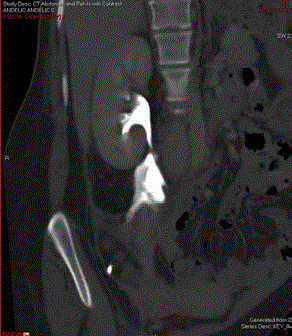Clinical Image
Spontaneous Ureteric Rupture after Forceps Delivery
Magdy Moustafa*
Department of Obstetrics and Gynecology, Frimley Park Hospital, UK
*Corresponding author: Magdy Moustafa, Department of Obstetrics and Gynecology, Frimley Park Hospital, Portsmouth Road, Frimley Camberley Surrey, GU16 6HD, UK
Published: 04 Sep, 2017
Cite this article as: Moustafa M. Spontaneous Ureteric
Rupture after Forceps Delivery. Ann
Clin Case Rep. 2017; 2: 1430.
Clinical Image
A 33 years old lady was admitted to the central delivery suit for induction of labour at 40 weeks+3
days having had pre labour spontaneous rupture of the membranes for more than 24 hours. She had
an easy mid cavity forceps delivery in theatre under epidural with 2 pulls and small episiotomy. A
temperature of 39.3°C developed during labour and antibiotics was started. Full blood count and
C reactive protein were within normal values. She was discharged a day after delivery in a good
condition.
She was readmitted after 24 hours with right iliac fossa pain. Appendicitis was excluded by
the surgical team with the advice to continue antibiotics and analgesia. An abdominal and pelvic
ultrasound was suggestive of the presence of right broad ligament haematoma of 8 cm x 6 cm.
She was treated conservatively for 3 days with no obvious improvement with right renal angle
tenderness.
In view of deterioration and spikes of temperature, the decision was made for CT guided
drainage of the collected fluid which was sent for culture and sensitivity. The laboratory suggested
that the aspirated fluid is urine. CT abdomen and pelvis with contrast revealed retroperitoneal
urinoma secondary to right ureteric damage 4 cm below the pelviureteric junction. A RJJ stent was
performed during cystoscopy.
Two month later the patient had cystoscopy and removal of the ureteric stent. An intravenous
urography 2 weeks later confirmed an intact ureter.
Non traumatic or spontaneous ureteral rupture in pregnancy and labour is a rare occurrence
and has been previously described in the literature and is usually seen at the fornix and upper ureter
[1]. The pathogenic pathway underlying non traumatic disruption of the urinary collecting system is an increased intraluminal pressure [2].
In pregnancy, urinary ductal system dilatation or hydronephrosis is common occurrence and
seen approximately in 80% of cases, mostly in the right side [3]. However in our patient, she has not any renal scan all through pregnancy and it is difficult to know that there was an element of
hydronephrosis during pregnancy.
The likelihood of an avulsive force injuring the ureter is unlikely as it is expected to be the lower
part of the ureter and associated with extended vaginal tear reaching the fornix which is not the case
in our patient. We hypothesize that the increased intraluminal pressure resulting from physiologic hydronephrosis of pregnancy in addition to rapid changes in intraabdominal
pressure while pushing might have resulted in the ureteral
rupture.
The contrast enhanced CT scan is the preferred imaging study for
renal trauma, to demonstrate the relationship between the urinoma
and the urogenital tract and the fascial planes [4].
If urinoma is left untreated can lead to serious complications
like perinephric abscess, urinary granuloma, retroperitoneal fibrosis,
paralytic ileus, systemic sepsis, electrolyte imbalance and ureteric
stenosis [5].
Rupture of the collecting system is best managed with drainage
either by percutaneous nephrostomy or ureteric stenting, as in our
case. The symptoms will usually resolve within days and the system
will heal uneventfully.
Figure 1
Figure 1
Coronal reconstruction of CT urogram showing extravasation of contrast form the proximal right ureter.
Acknowledgement
The author is very grateful to DR/Germey Taylor Consultant Radiologist/Frimley Park Hospital for his help in preparing this article.
References
- Pampana E, Altoblli S, Morini M, A Ricci, S D'Onofrio, G Simonetti. Spontaneous ureteral rupture diagnosis and treatment. Case Rep Radiol. 2013; 851859.
- Narasimhulu DM, Egbert NM, Matthew S. Intrpartum spontaneous ureteral rupture. Obstetrics Gynaecology. 2015; 126: 610-612.
- Dhabuwala CB, Riehle RA. Spontaneous rupture of hydronephrotic kidney during pregnancy. Urology. 1984; 24: 591-594.
- Federle MP, Brown TR, Mc Aninch JW. Penetrating renal trauma: CT evaluation. Journal of Computer Assisted Tomography. 1987; 11: 1026-1030.
- Kumar A, Suman SK, Khan I, Pridarshi S. Spontaneous perinephric urinoma in a postpartum woman: case report and review. Int J Sci Stud. 2014; 2: 154-156.

